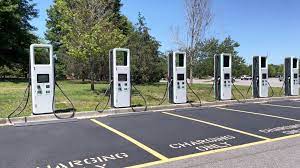The integration of electric vehicle (EV) charging stations into building design marks a pivotal moment in sustainable architecture. This trend reflects not just a shift towards eco-friendly transportation but also a broader commitment to sustainable living. As the world grapples with climate change, architects and developers are increasingly recognizing the importance of designing buildings that accommodate and encourage the use of electric vehicles.
The concept goes beyond mere convenience for EV owners. It’s about envisioning a future where buildings and transportation coexist in an eco-friendly ecosystem. This integration is a response to the growing demand for sustainable living spaces, where the carbon footprint of every aspect of life, including transportation, is minimized.
The challenge lies in seamlessly blending EV charging infrastructure into existing and new buildings without disrupting aesthetic appeal or functional design. Architects and urban planners must consider factors such as location, energy sourcing, and user convenience while ensuring that the infrastructure complements the building’s overall sustainability goals.
Moreover, the integration of EV charging stations in buildings is not just an environmental statement; it’s an economic one. As more consumers opt for electric vehicles, buildings with integrated charging facilities will likely see an increase in value, making this a wise investment in the future of real estate.
The Role of Technology in EV Integration
Incorporating EV charging stations into building designs requires innovative technological solutions. This involves not just the physical installation of charging equipment but also the integration with building management systems and smart grids. The goal is to create a symbiotic relationship between the vehicle, the building, and the wider energy network.
Smart technology plays a crucial role in this integration. Building management systems can be programmed to optimize energy use, ensuring that EV charging does not overload the grid and is powered, as much as possible, by renewable sources. This smart integration can significantly reduce the environmental impact of both the building and the vehicles it supports.
Furthermore, the technology needs to be adaptable and scalable. As EV technology evolves and the number of electric vehicles increases, the charging infrastructure must be able to grow and adapt accordingly. This foresight will prevent future obsolescence and ensure that the building remains at the forefront of sustainability.
User experience is also a key consideration. The interface for managing charging should be intuitive and accessible, allowing building occupants to easily charge their vehicles. This user-friendly approach is essential for encouraging widespread adoption of EVs and making sustainable living a convenient choice for all.
Design Considerations and Challenges
Designing a building with integrated EV charging stations presents unique challenges. Architects must consider the placement of charging ports, ensuring they are accessible yet unobtrusive. This often requires innovative thinking, especially in dense urban environments where space is at a premium.
Energy efficiency is another critical factor. The additional load of EV charging stations must be balanced with the building’s overall energy consumption. This may involve incorporating renewable energy sources, such as solar panels, to offset the increased demand. It’s a delicate balance between functionality, sustainability, and aesthetic value.
The design must also be future-proof. This means accommodating advancements in EV technology, such as faster charging times and larger batteries. It’s essential to design a system that can be easily upgraded as technology evolves, ensuring the building remains relevant and functional in the long term.
Cost is also a significant factor. While integrating EV charging stations into a building’s design can increase its value, it also involves initial investment. Finding cost-effective solutions without compromising on quality or sustainability is a challenge that requires creative problem-solving and strategic planning.
Collaboration with Clean Energy Providers
Successful integration of EV charging stations into building designs often involves collaboration with specialized clean energy providers. Companies like Zero Impact Energy Group (ZIEG) play a crucial role in this process. ZIEG, and under its umbrella organization, Zero Impact Solutions (ZIS), offer a comprehensive suite of services that includes financing, education, and the construction of EVSE sites, including level 2 and level 3 charging station installation. Their expertise in clean energy solutions, particularly in California, makes them ideal partners for sustainable building projects.
Their proprietary EV charging software system, Evolv, enhances the functionality and user experience of EV charging stations. By offering a seamless way to manage, monitor, and monetize EV charging infrastructure, Evolv sets a high standard in the integration of clean energy technology into building design.
This collaboration is not just about installing hardware; it’s about creating a cohesive system where buildings and EV charging infrastructure work in harmony. The expertise of companies like ZIEG ensures that the integration of EV charging stations contributes to the building’s overall sustainability goals and enhances the user experience.
Moreover, working with specialized clean energy providers can bring financial benefits. They can help navigate the complex landscape of rebates and financial incentives, making the integration of EV charging stations more economically viable for building projects.
Impact on Urban Planning and Development
The incorporation of EV charging stations in building design has significant implications for urban planning and development. As cities evolve, the need for sustainable transportation solutions becomes increasingly critical. Integrated EV charging infrastructure in buildings is a step towards creating more environmentally friendly urban spaces.
This trend necessitates a rethinking of urban landscapes. City planners must now consider EV charging accessibility in their designs, much like they would other utilities. This shift has the potential to transform the way cities are laid out, with EV charging capacity becoming a standard consideration in both residential and commercial developments.
The integration also encourages a more widespread adoption of EVs. By making charging stations readily available in homes, workplaces, and public buildings, the barrier to EV ownership is significantly lowered. This can lead to a decrease in urban pollution and a move towards cleaner, more sustainable cities.
Additionally, this development can spur the growth of green zones in urban areas, where lower emissions are encouraged or mandated. Buildings with integrated EV charging stations will be at the forefront of this movement, setting the standard for future construction and urban development.
However, this shift also presents challenges, such as ensuring equitable access to charging facilities across different socio-economic areas. Urban planners must work to prevent a disparity where EV charging infrastructure is abundant in wealthier neighborhoods but scarce in less affluent ones.
Environmental Impact and Sustainability Goals
Integrating EV charging stations into building designs aligns with broader environmental and sustainability goals. By encouraging the use of electric vehicles, these buildings contribute to the reduction of greenhouse gas emissions and reliance on fossil fuels.
The move towards sustainable building design, including EV charging integration, is a response to the urgent need to address climate change. Buildings are significant energy consumers, and their design plays a crucial role in the global environmental impact. Incorporating EV charging stations is a step towards creating a more sustainable and responsible built environment.
This integration also promotes the use of renewable energy sources. For instance, buildings equipped with solar panels can use the generated energy to power EV charging stations, creating a closed-loop system that is both sustainable and efficient.
Furthermore, sustainable building design, including EV charging stations, often leads to long-term cost savings. Although the initial investment might be higher, the reduced energy costs and potential revenue from EV charging services can make these buildings more economically viable in the long run.
Economic Benefits and Market Trends
The market for sustainable buildings with integrated EV charging stations is growing rapidly. This trend is driven by increasing environmental awareness, government incentives, and a shift in consumer preferences towards sustainability.
Property developers who invest in such buildings are likely to see a competitive advantage. As more people choose EVs, the demand for properties with charging facilities will rise. This can lead to higher property values and rental rates, making sustainable building design a smart economic choice.
The integration of EV charging stations also opens up new revenue streams for building owners. They can charge fees for charging services, creating a new income source. This can be particularly lucrative in commercial and retail spaces, where the footfall is high.
In addition to direct economic benefits, there are also indirect advantages. Buildings that prioritize sustainability and modern amenities like EV charging stations can attract a more environmentally conscious clientele, enhancing the building’s reputation and appeal.
Challenges and Solutions in Implementation
While the benefits are clear, integrating EV charging stations into buildings also comes with challenges. One of the primary issues is the cost of installation and maintenance. To address this, building owners and developers can explore various financing options, including government grants and partnerships with clean energy companies.
Another challenge is the technological integration. The EV charging infrastructure needs to be seamlessly integrated into the building’s existing energy systems. This requires expert knowledge and often, the collaboration with specialized companies.
There is also the challenge of space. In densely populated urban areas, finding space for EV charging stations can be difficult. Creative solutions, such as multi-level charging facilities or compact charging stations, can be employed to overcome this hurdle.
Additionally, ensuring that the electricity used for charging is sourced from renewable energy is crucial for truly sustainable implementation. This may involve installing solar panels or entering into power purchase agreements with renewable energy providers.
Paving the Way for a Sustainable Future
The integration of EV charging stations into sustainable building design is more than a trend; it’s a necessary step towards a more environmentally friendly future. As we move towards cleaner transportation options, the role of buildings in supporting this transition becomes increasingly important.
This integration not only benefits the environment but also offers economic advantages and aligns with evolving market trends. While challenges exist, they are not insurmountable, especially with the collaboration of specialized companies and the use of innovative solutions.
As we look forward, the hope is that sustainable building design, including EV charging integration, becomes the norm rather than the exception. This shift is essential for reducing our carbon footprint and creating a more sustainable world for future generations.
Write and Win: Participate in Creative writing Contest & International Essay Contest and win fabulous prizes.
















